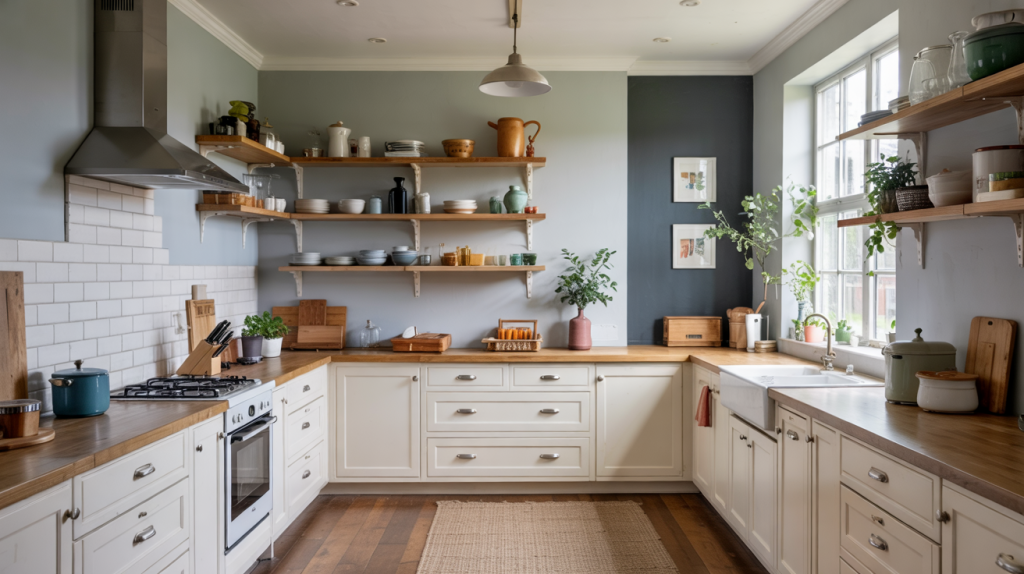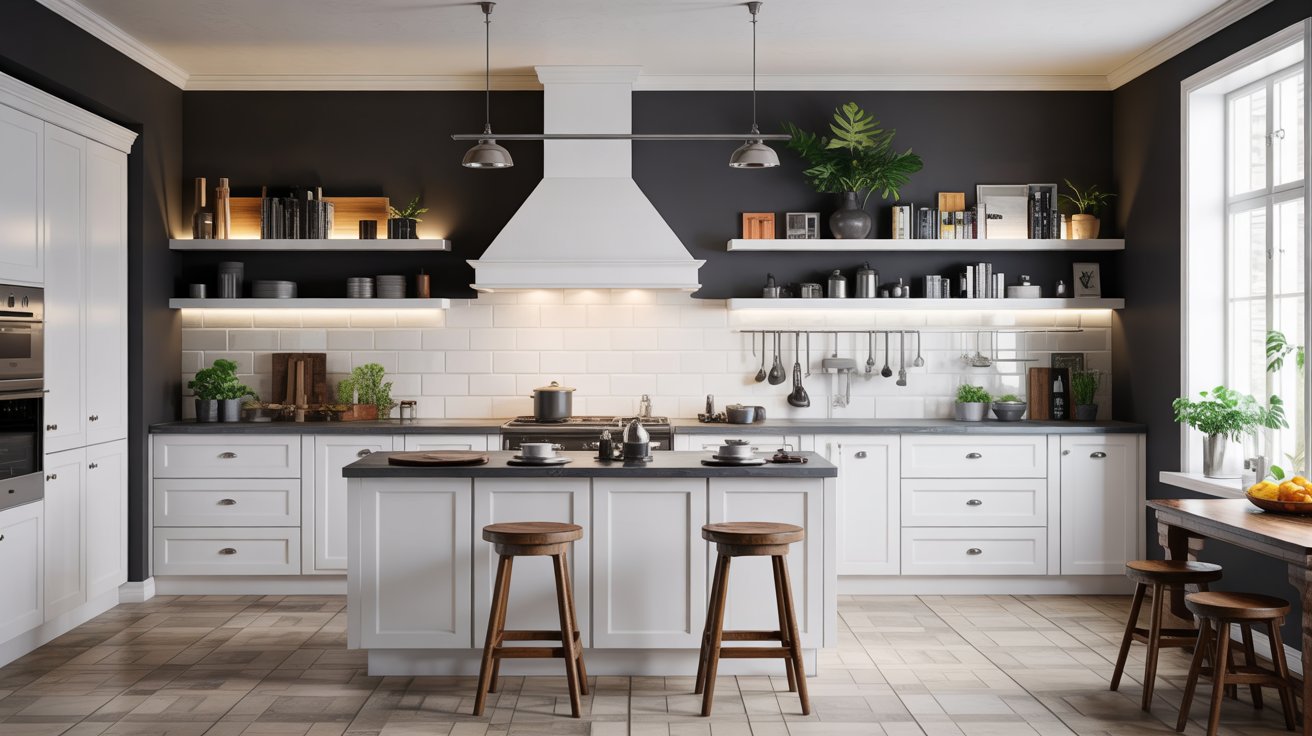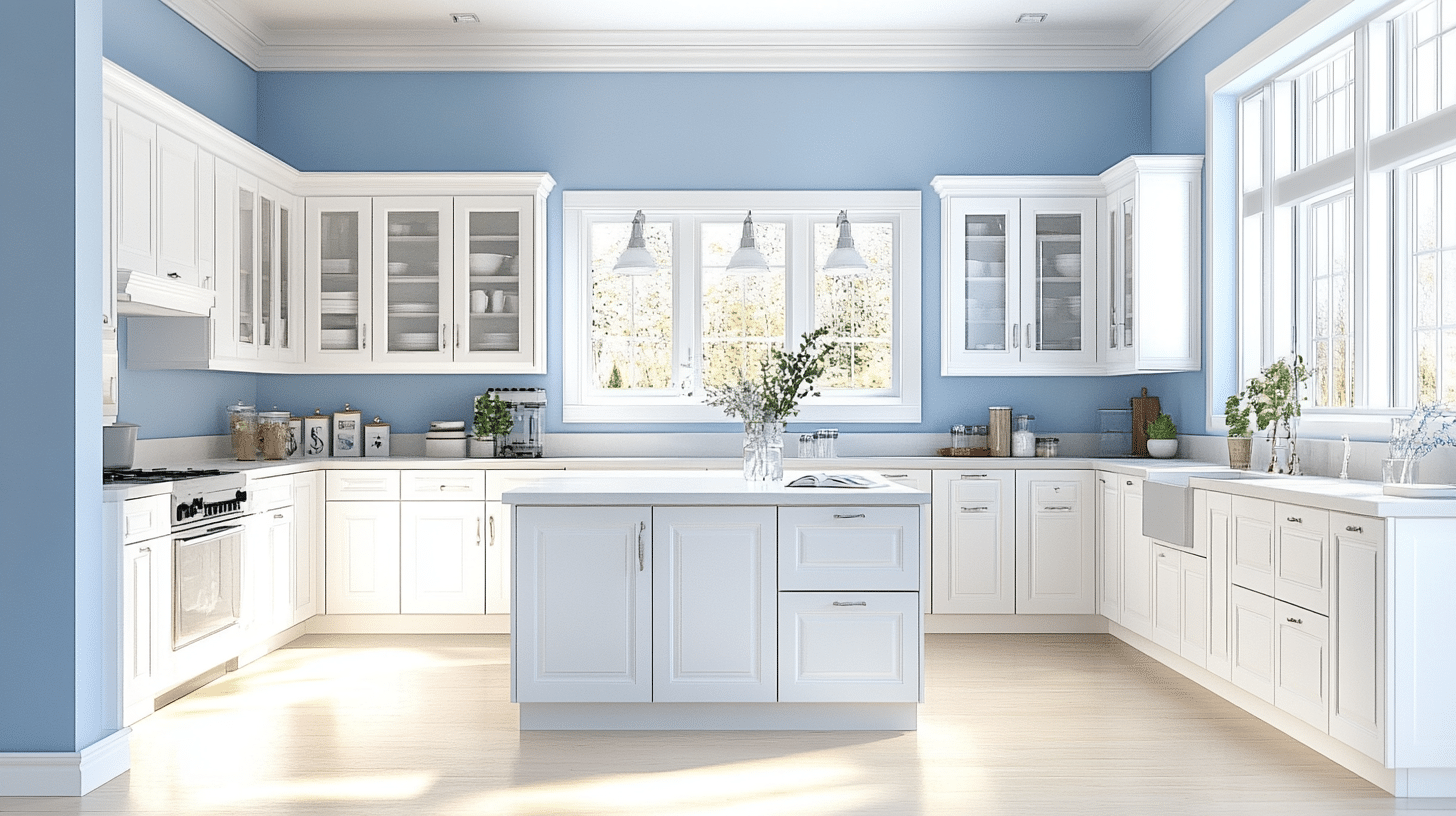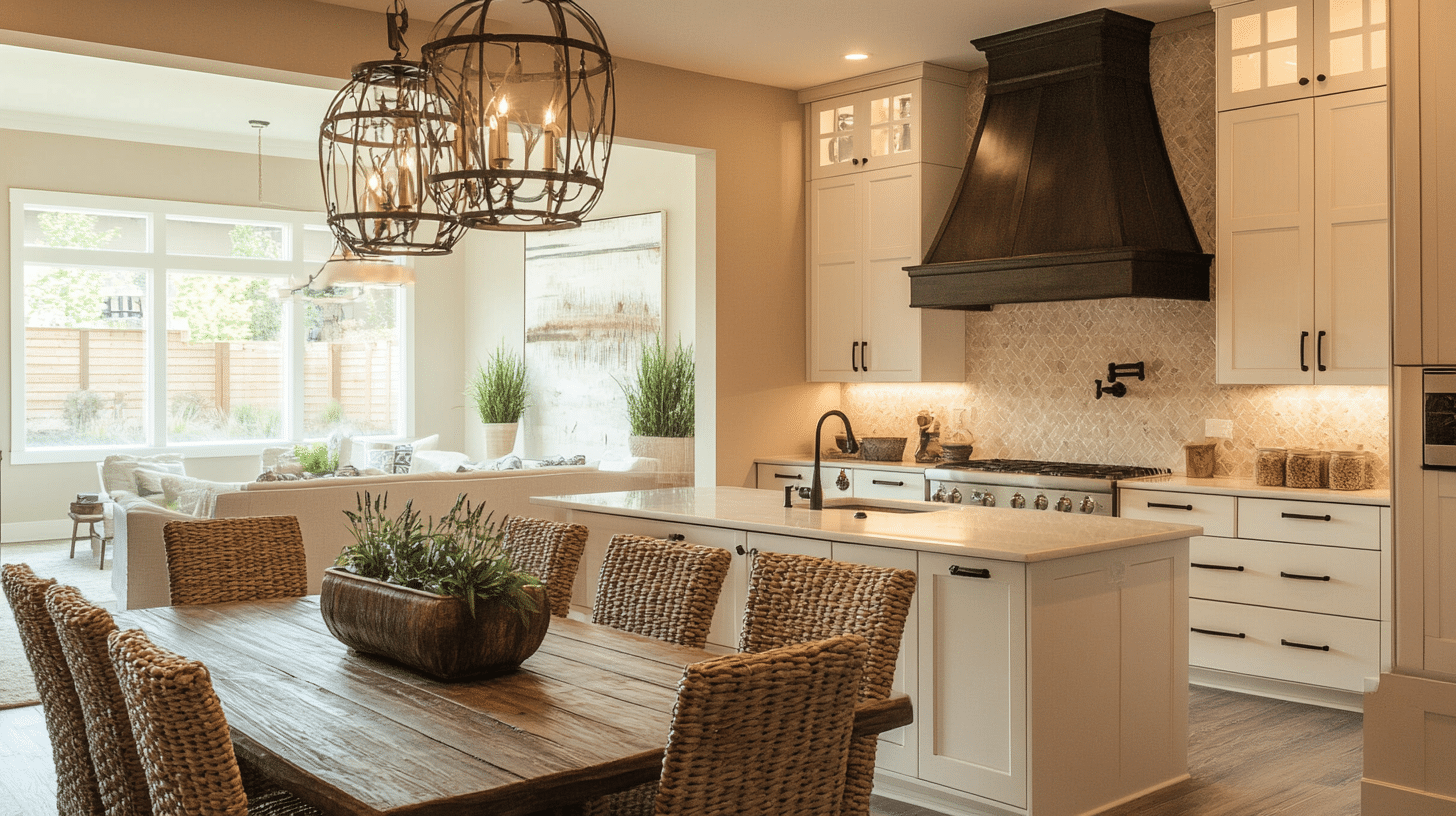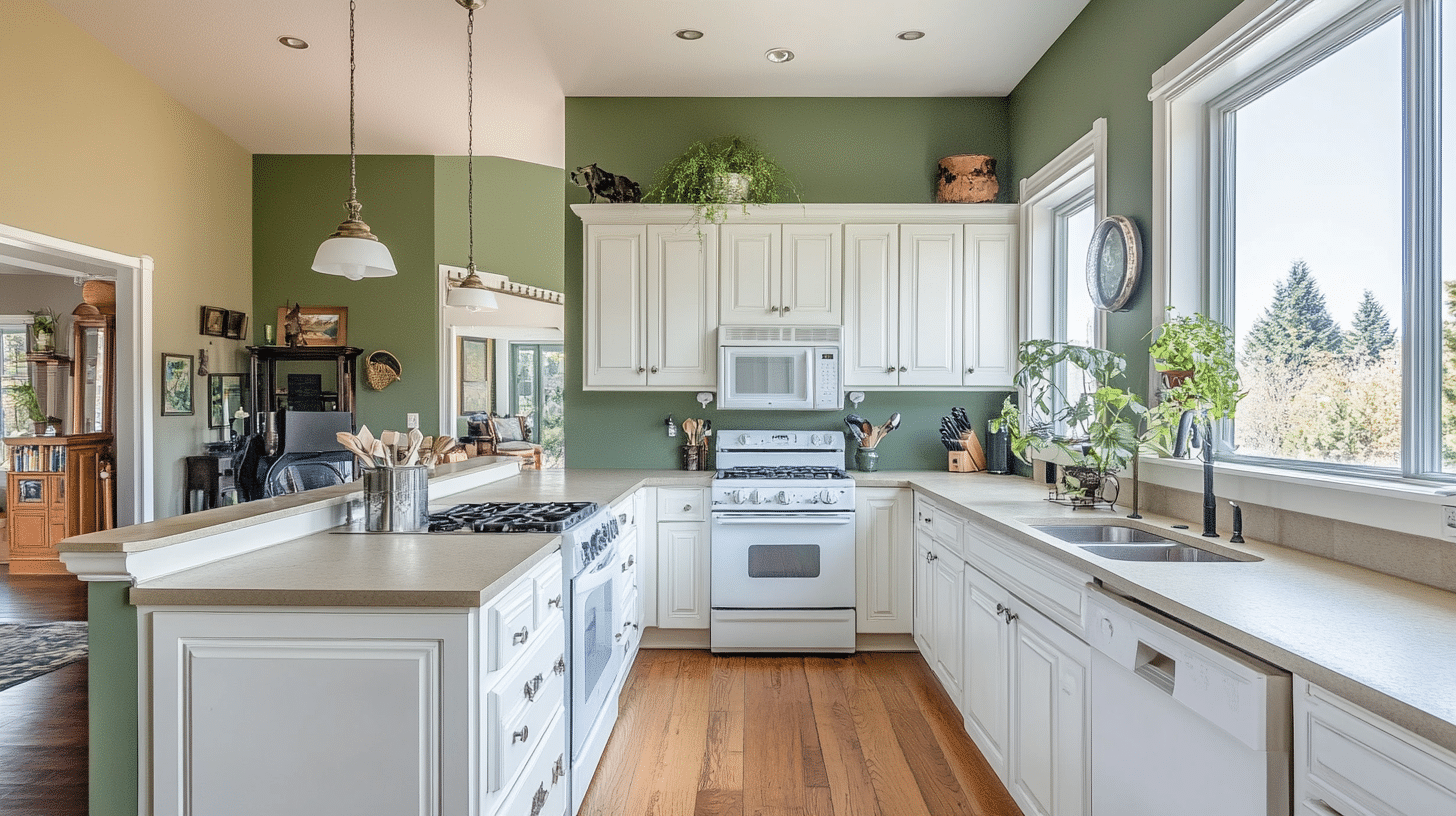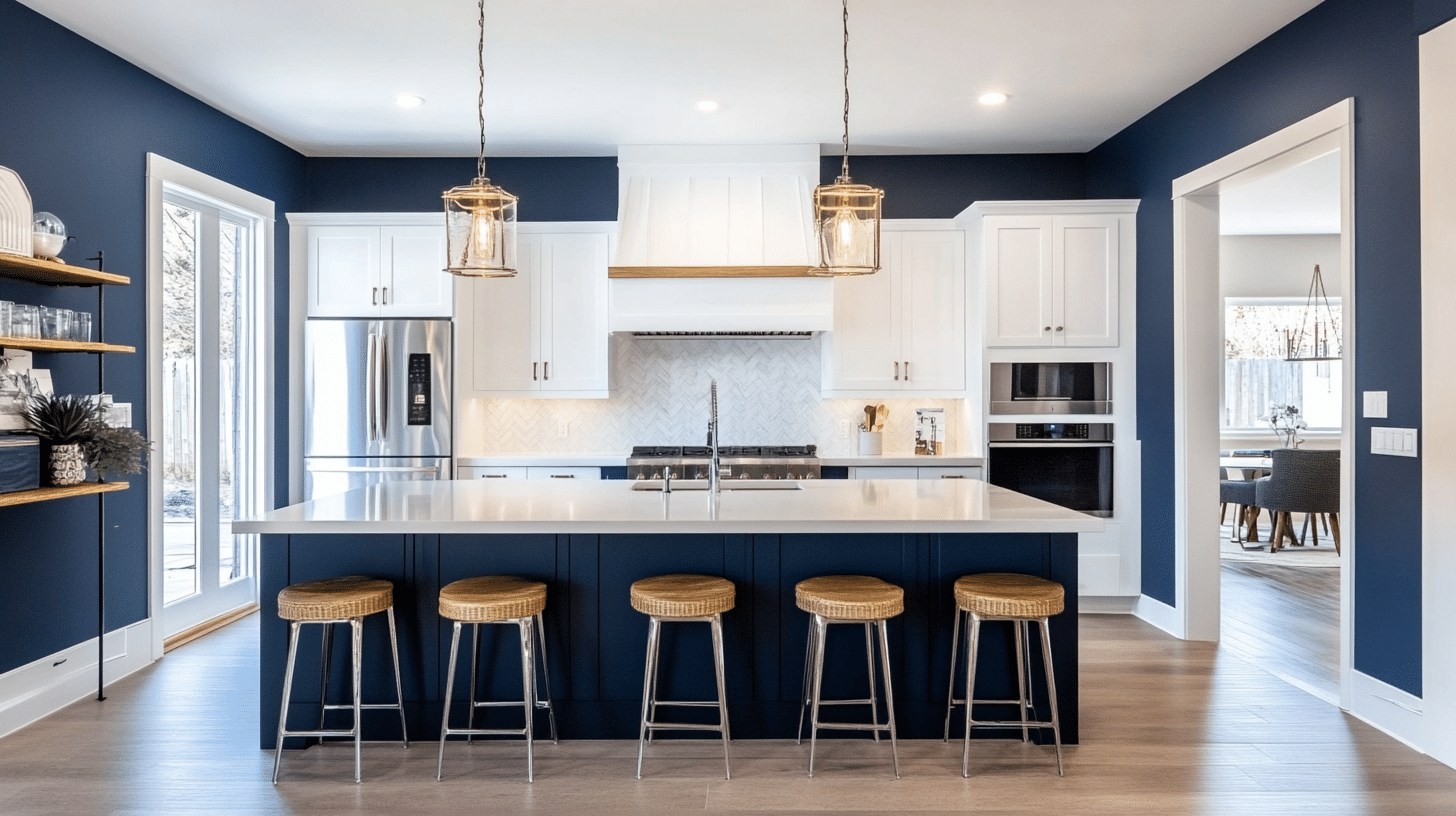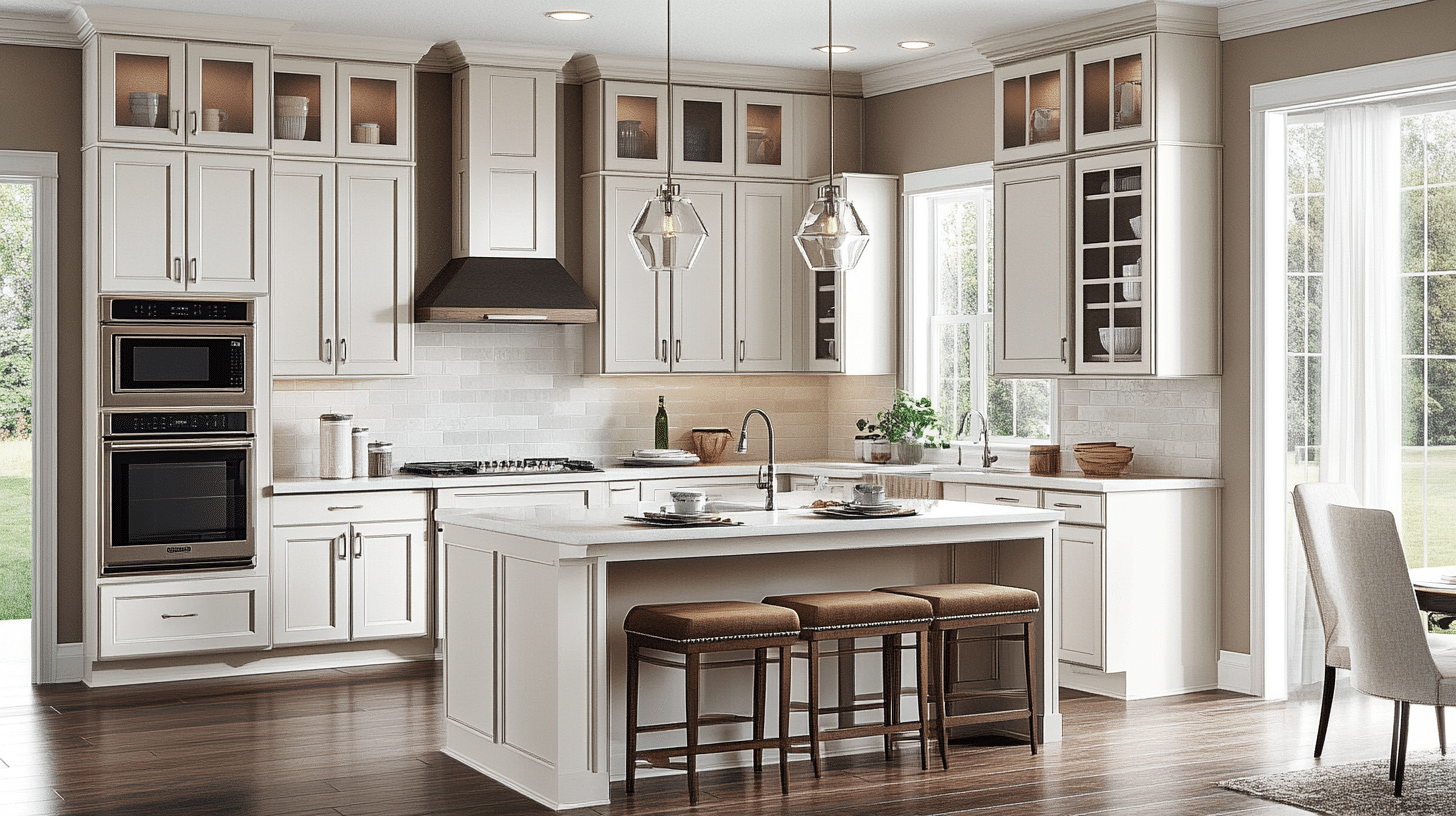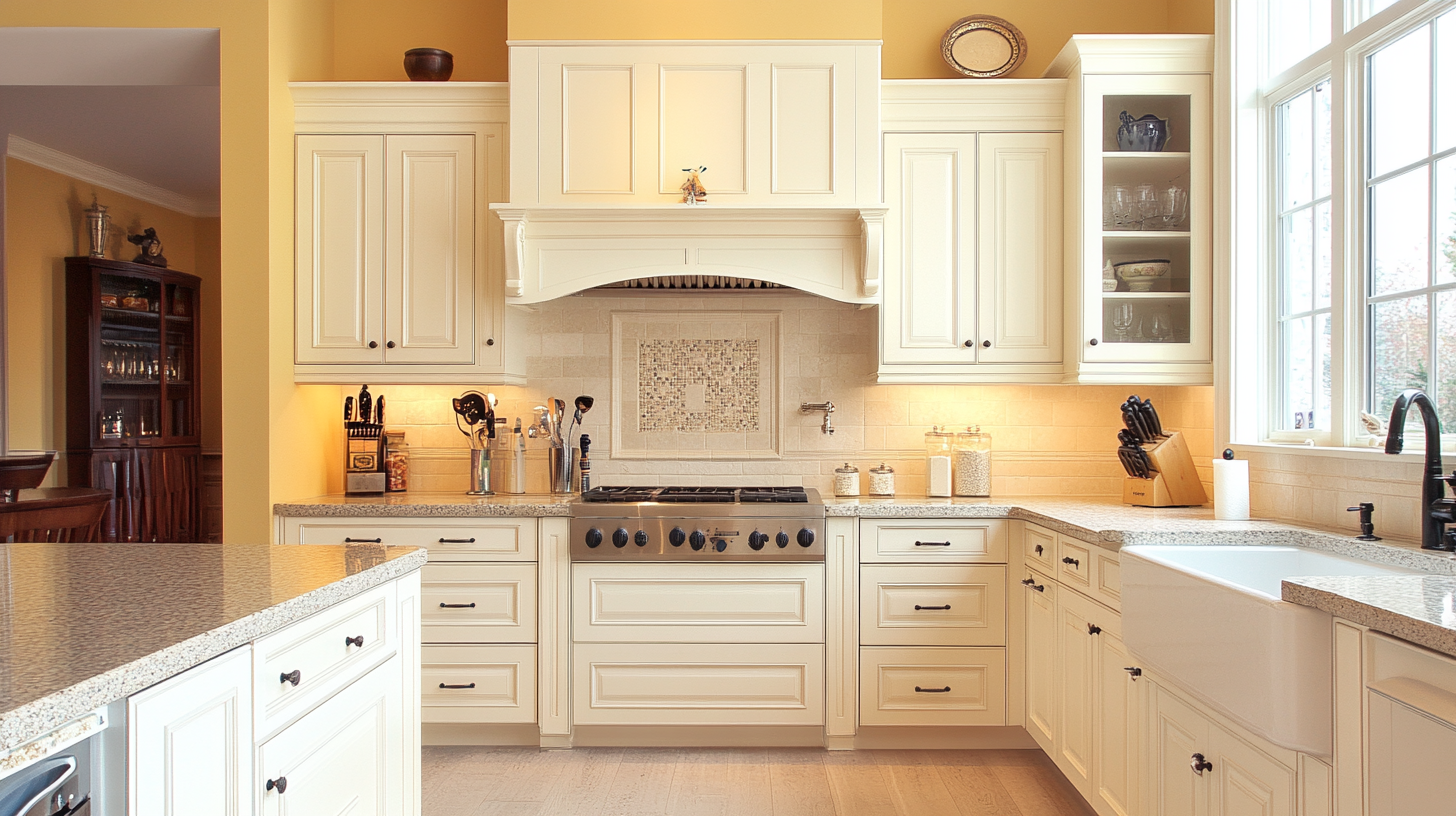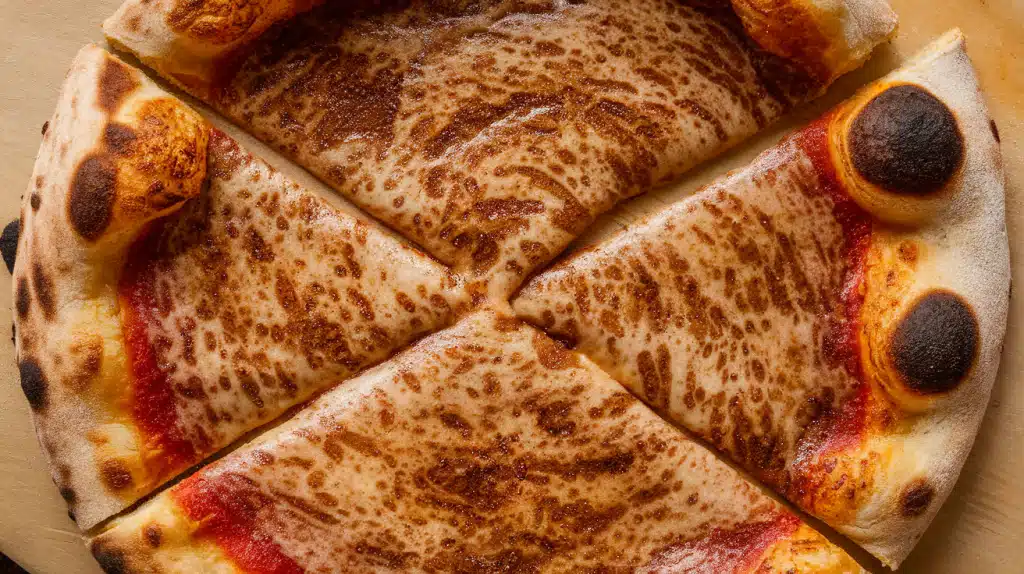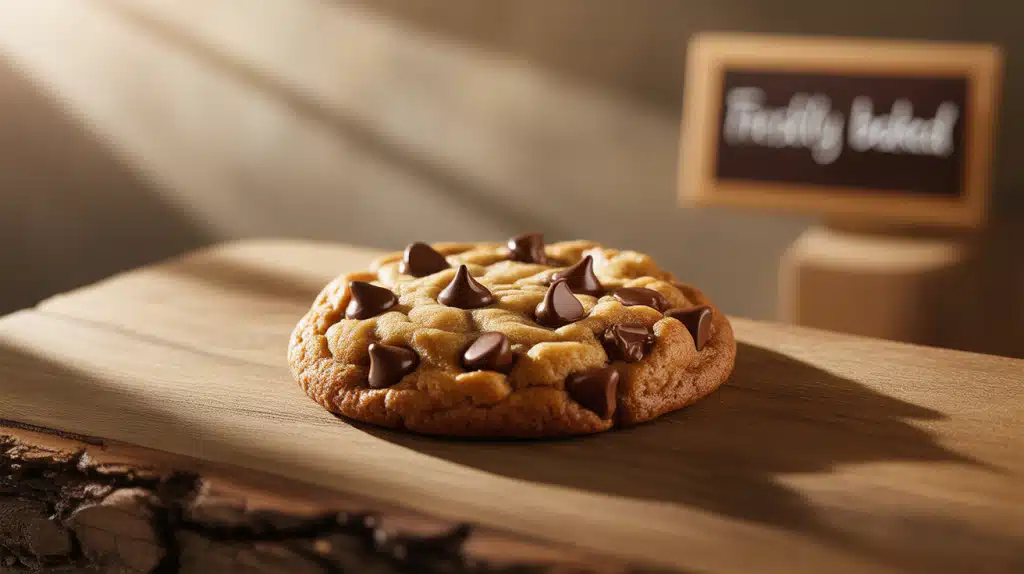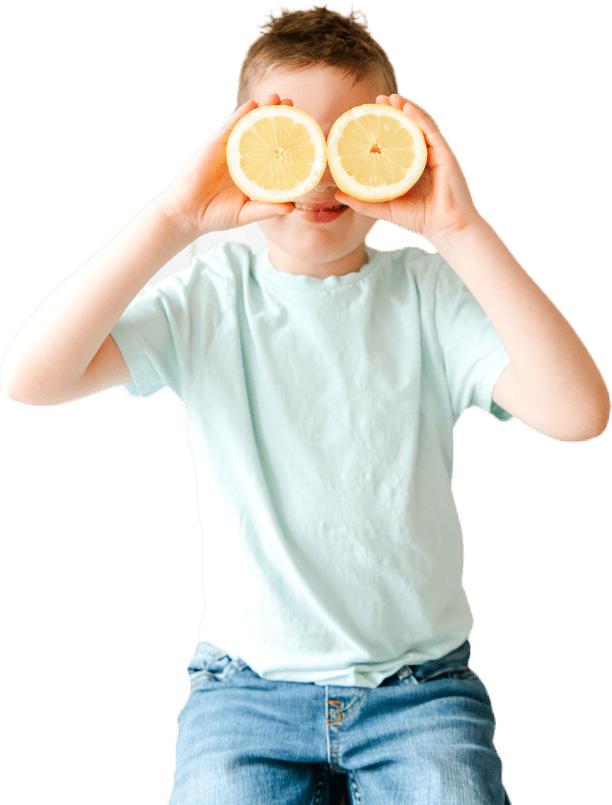White cabinets. Clean, basic, timeless.
But the wrong wall color turns your kitchen into a cold, lifeless space that feels like a sterile lab. You’ve stared at paint samples for hours, yet nothing seems right. The stress builds as you try to make your kitchen both practical and pleasing.
Good news! The perfect paint color exists for your white cabinets. This guide shows you eight tried-and-tested colors that work well with white cabinets. You’ll learn which shades create warmth, which ones add contrast, and which ones make small kitchens feel bigger. By the end, you’ll know exactly which color to pick for your kitchen walls.
Let’s look at these eight colors now.
8 Best Kitchen Paint Colors to Match White Cabinets
1. Soft Gray – A Subtle Contrast
Soft gray adds quiet depth next to white cabinets without stealing attention. Light grays create a clean look, while mid-tones add subtle contrast. The color brings a calm feel that works in any light. Gray walls make white cabinets look crisp and clean.
This color combo fits in small or large kitchens and suits many styles from farmhouse to modern. Gray also hides marks and smudges better than lighter colors, making it practical for busy kitchens.
Complementary Accents: Wood tones, black hardware, and green plants stand out well against gray walls and white cabinets.
Mood and Atmosphere: Creates a peaceful, collected feeling that feels both modern and classic at once.
Best shades of gray:
2. Light Blue – A Cool, Refreshing Vibe
Light blue brings a fresh, airy quality that makes kitchens feel open. Pale blue-gray or soft sky blue tones pair well with the crisp look of white cabinets without fighting for attention.
This color recalls clear skies and open water, bringing nature inside. Blue walls make white cabinets pop while keeping the room feeling light. The combo works well in both north and south-facing rooms, adapting to changing light throughout the day.
Complementary Accents: Brass fixtures, light wood, and glass items enhance the fresh feel of blue and white.
Mood and Atmosphere: Creates a calm, clean space that feels like a breath of fresh air.
Best shades of light blue:
3. Warm Beige – Neutral Grace
Beige adds soft warmth that keeps white cabinets from feeling too cold. It works with many styles from classic to modern. Sand-toned beiges create a light, open feel while darker tans add more contrast.
Beige walls let cabinet details stand out. This color stays in style year after year, making it a safe choice for those who don’t want to repaint often. Beige also makes a kitchen feel more lived-in than stark white.
Complementary Accents: Bronze hardware, terracotta pots, and warm metals create a tied-together look.
Mood and Atmosphere: Builds a cozy, welcoming space that feels lived-in and comfortable.
Best shades of beige:
4. Sage Green – A Touch of Nature
Sage green brings the outside in, creating a link to nature. The soft, gray-green shade adds life to white cabinets without being too bold. It works in both small and large kitchens.
Sage acts as a middle ground between cool and warm colors. This green shade changes with the light, looking more silver in dim light and more green in bright sun. It makes white cabinets look clean and bright without harsh contrast.
Complementary Accents: Clay pots, woven baskets, and copper items stand out against sage walls.
Mood and Atmosphere: Offers a fresh, grounded feeling that puts people at ease and feels good all day.
Best shades of sage green:
5. Classic Navy Blue – Bold Contrast with White Cabinets
Navy blue creates a strong contrast that makes white cabinets pop. The deep color adds depth while white keeps the space from feeling dark. Navy works well as an accent wall or full kitchen color.
This classic blue shade never goes out of style. Navy walls make a kitchen feel planned and complete. The color works well with most countertop materials and floor types, giving you more options with other features.
Complementary Accents: Gold hardware, marble tops, and glass lights enhance the rich look.
Mood and Atmosphere: Builds a strong, bold space that feels put-together and planned with care.
Best shades of navy:
6. Soft Taupe – Modern and Timeless
Taupe sits between gray and beige, offering the best of both worlds. This mixed neutral adds warmth while staying cool enough to feel current. It changes with the light, looking different throughout the day.
Taupe has pink or purple hints that add depth to kitchen walls. It works with both cool and warm whites, making cabinet selection easier. Taupe lets other kitchen items take center stage while still adding more interest than plain white.
Complementary Accents: Black matte fixtures, wood cutting boards, and stone items work well with taupe.
Mood and Atmosphere: Creates a quiet, balanced feeling that feels both now and forever.
Best shades of taupe:
7. Light Yellow – Adding Warmth and Cheer
Light yellow brings sunshine into the kitchen without being too bright. Pale butter or cream tones add a happy glow that makes white cabinets look crisp and clean in return. Yellow walls feel warm even on cold days. This color works well in north-facing kitchens that need help feeling warm. Yellow brightens dark corners and makes small kitchens feel bigger. It pairs well with most floor colors from light to dark.
Complementary Accents: Blue items, white dishes, and green plants create balance with yellow walls.
Mood and Atmosphere: Builds a sunny, hopeful space that feels like the start of a good day.
Best shades of light yellow:
8. Charcoal – Sleek, Modern, and Dramatic
Charcoal creates the highest contrast with white, making a bold statement. The near-black shade adds depth and drama that makes white look even brighter and cleaner by comparison. Charcoal walls make a kitchen feel smaller in a good way – more cozy and defined. This dark tone hides marks and stains better than any other color. It works best in kitchens with good natural light or plenty of added lighting.
Complementary Accents: Steel appliances, light wood, and bright art stand out perfectly against dark walls.
Mood and Atmosphere: Creates a strong, focused feeling that makes the kitchen feel like a designed space.
Best shades of charcoal:
Disclaimer: The products mentioned in this blog are based solely on personal experience and are not sponsored or affiliated with any brands.
Should Walls Be Lighter or Darker Than Kitchen Cabinets?
When deciding if your kitchen walls should be lighter or darker than your cabinets, consider the size of the room, the amount of natural light, and the mood you want to create.
-
Lighter Walls: Light-colored walls (like soft whites or pale grays) make smaller kitchens feel more open and airy. They reflect light and complement white or neutral cabinets, creating a fresh, spacious feel.
-
Darker Walls: Darker tones (like navy, charcoal, or deep green) add drama and sophistication. They work well in larger kitchens with ample natural light, providing a bold contrast with white or light cabinets.
-
Mid-Tone Walls: Neutral shades (such as warm taupes or soft greys) offer a balanced approach, adding warmth and depth without overwhelming the space. This option is great for any kitchen size.
In short, lighter walls brighten up smaller spaces, while darker walls create a stylish contrast in larger rooms. Mid-tones offer a balanced and versatile alternative for most kitchens.
Conclusion
White cabinets give you plenty of options for wall colors. Each color we’ve looked at brings something different to your kitchen.
So what color should you pick? Think about what feeling you want in your kitchen. Do you want it calm and peaceful? Try soft gray or sage green. Want something bold? Navy or charcoal might be your pick.
Don’t forget to test paint samples on your walls. Colors look different depending on your lighting and other elements in your kitchen.
Ready to paint? Start with one wall as a test before doing the whole kitchen. This lets you live with the color for a while.
What’s your next step? Pick up some sample pots of your top two choices and see how they look in your space!

